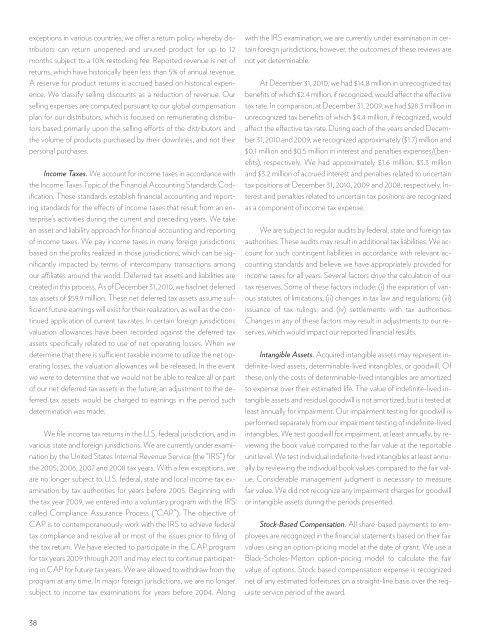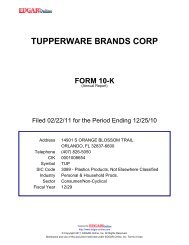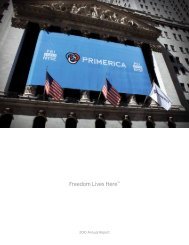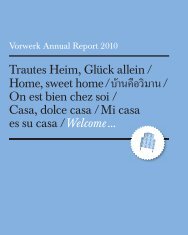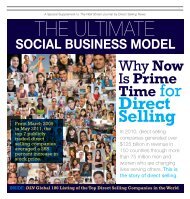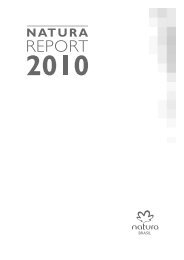Nu Skin 2010 Annual Report - Direct Selling News
Nu Skin 2010 Annual Report - Direct Selling News
Nu Skin 2010 Annual Report - Direct Selling News
Create successful ePaper yourself
Turn your PDF publications into a flip-book with our unique Google optimized e-Paper software.
exceptions in various countries, we offer a return policy whereby distributors<br />
can return unopened and unused product for up to 12<br />
months subject to a 10% restocking fee. <strong>Report</strong>ed revenue is net of<br />
returns, which have historically been less than 5% of annual revenue.<br />
A reserve for product returns is accrued based on historical experience.<br />
We classify selling discounts as a reduction of revenue. Our<br />
selling expenses are computed pursuant to our global compensation<br />
plan for our distributors, which is focused on remunerating distributors<br />
based primarily upon the selling efforts of the distributors and<br />
the volume of products purchased by their downlines, and not their<br />
personal purchases.<br />
Income Taxes. We account for income taxes in accordance with<br />
the Income Taxes Topic of the Financial Accounting Standards Codification.<br />
These standards establish financial accounting and reporting<br />
standards for the effects of income taxes that result from an enterprise’s<br />
activities during the current and preceding years. We take<br />
an asset and liability approach for financial accounting and reporting<br />
of income taxes. We pay income taxes in many foreign jurisdictions<br />
based on the profits realized in those jurisdictions, which can be significantly<br />
impacted by terms of intercompany transactions among<br />
our affiliates around the world. Deferred tax assets and liabilities are<br />
created in this process. As of December 31, <strong>2010</strong>, we had net deferred<br />
tax assets of $59.9 million. These net deferred tax assets assume sufficient<br />
future earnings will exist for their realization, as well as the continued<br />
application of current tax rates. In certain foreign jurisdictions<br />
valuation allowances have been recorded against the deferred tax<br />
assets specifically related to use of net operating losses. When we<br />
determine that there is sufficient taxable income to utilize the net operating<br />
losses, the valuation allowances will be released. In the event<br />
we were to determine that we would not be able to realize all or part<br />
of our net deferred tax assets in the future, an adjustment to the deferred<br />
tax assets would be charged to earnings in the period such<br />
determination was made.<br />
We file income tax returns in the U.S. federal jurisdiction, and in<br />
various state and foreign jurisdictions. We are currently under examination<br />
by the United States Internal Revenue Service (the “IRS”) for<br />
the 2005, 2006, 2007 and 2008 tax years. With a few exceptions, we<br />
are no longer subject to U.S. federal, state and local income tax examination<br />
by tax authorities for years before 2005. Beginning with<br />
the tax year 2009, we entered into a voluntary program with the IRS<br />
called Compliance Assurance Process (“CAP”). The objective of<br />
CAP is to contemporaneously work with the IRS to achieve federal<br />
tax compliance and resolve all or most of the issues prior to filing of<br />
the tax return. We have elected to participate in the CAP program<br />
for tax years 2009 through 2011 and may elect to continue participating<br />
in CAP for future tax years. We are allowed to withdraw from the<br />
program at any time. In major foreign jurisdictions, we are no longer<br />
subject to income tax examinations for years before 2004. Along<br />
with the IRS examination, we are currently under examination in certain<br />
foreign jurisdictions; however, the outcomes of these reviews are<br />
not yet determinable.<br />
At December 31, <strong>2010</strong>, we had $14.8 million in unrecognized tax<br />
benefits of which $2.4 million, if recognized, would affect the effective<br />
tax rate. In comparison, at December 31, 2009, we had $28.3 million in<br />
unrecognized tax benefits of which $4.4 million, if recognized, would<br />
affect the effective tax rate. During each of the years ended December<br />
31, <strong>2010</strong> and 2009, we recognized approximately ($1.7) million and<br />
$0.1 million and $0.5 million in interest and penalties expenses/(benefits),<br />
respectively. We had approximately $1.6 million, $3.3 million<br />
and $3.2 million of accrued interest and penalties related to uncertain<br />
tax positions at December 31, <strong>2010</strong>, 2009 and 2008, respectively. Interest<br />
and penalties related to uncertain tax positions are recognized<br />
as a component of income tax expense.<br />
We are subject to regular audits by federal, state and foreign tax<br />
authorities. These audits may result in additional tax liabilities. We account<br />
for such contingent liabilities in accordance with relevant accounting<br />
standards and believe we have appropriately provided for<br />
income taxes for all years. Several factors drive the calculation of our<br />
tax reserves. Some of these factors include: (i) the expiration of various<br />
statutes of limitations; (ii) changes in tax law and regulations; (iii)<br />
issuance of tax rulings; and (iv) settlements with tax authorities.<br />
Changes in any of these factors may result in adjustments to our reserves,<br />
which would impact our reported financial results.<br />
Intangible Assets. Acquired intangible assets may represent indefinite-lived<br />
assets, determinable-lived intangibles, or goodwill. Of<br />
these, only the costs of determinable-lived intangibles are amortized<br />
to expense over their estimated life. The value of indefinite-lived intangible<br />
assets and residual goodwill is not amortized, but is tested at<br />
least annually for impairment. Our impairment testing for goodwill is<br />
performed separately from our impairment testing of indefinite-lived<br />
intangibles. We test goodwill for impairment, at least annually, by reviewing<br />
the book value compared to the fair value at the reportable<br />
unit level. We test individual indefinite-lived intangibles at least annually<br />
by reviewing the individual book values compared to the fair value.<br />
Considerable management judgment is necessary to measure<br />
fair value. We did not recognize any impairment charges for goodwill<br />
or intangible assets during the periods presented.<br />
Stock-Based Compensation. All share-based payments to employees<br />
are recognized in the financial statements based on their fair<br />
values using an option-pricing model at the date of grant. We use a<br />
Black-Scholes-Merton option-pricing model to calculate the fair<br />
value of options. Stock based compensation expense is recognized<br />
net of any estimated forfeitures on a straight-line basis over the requisite<br />
service period of the award.<br />
38


